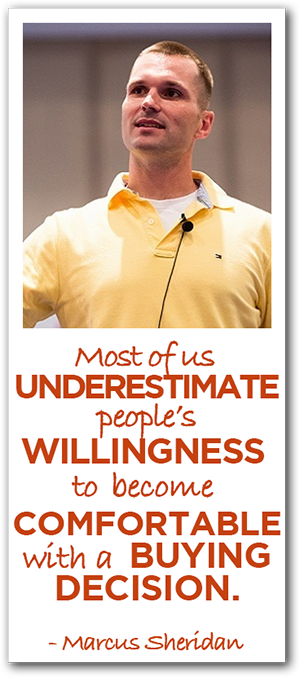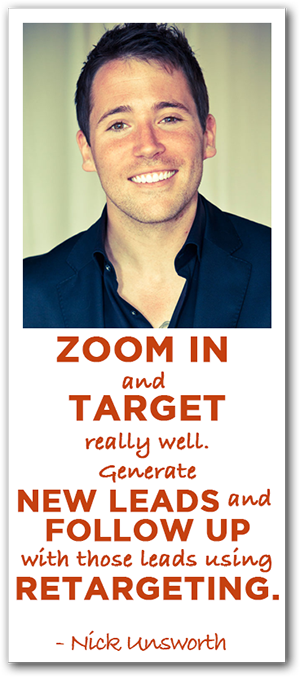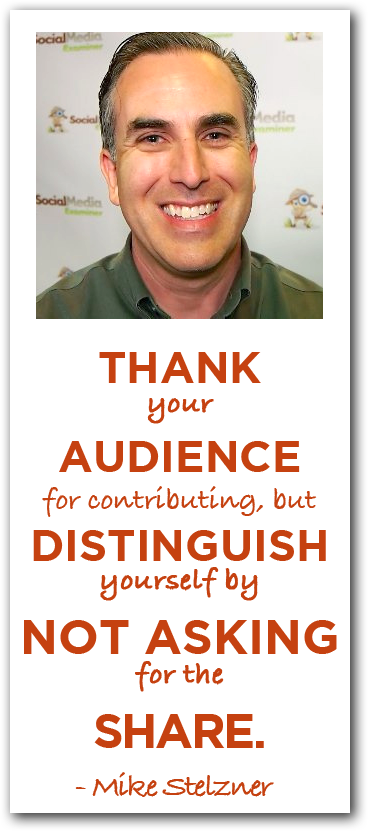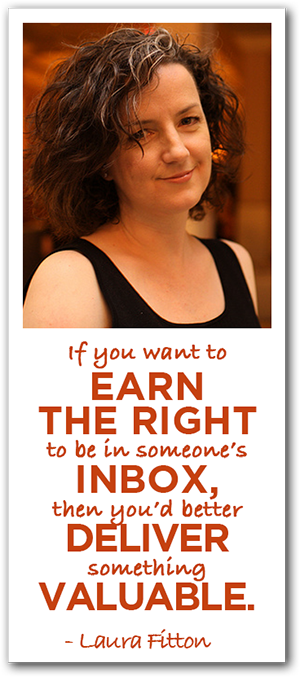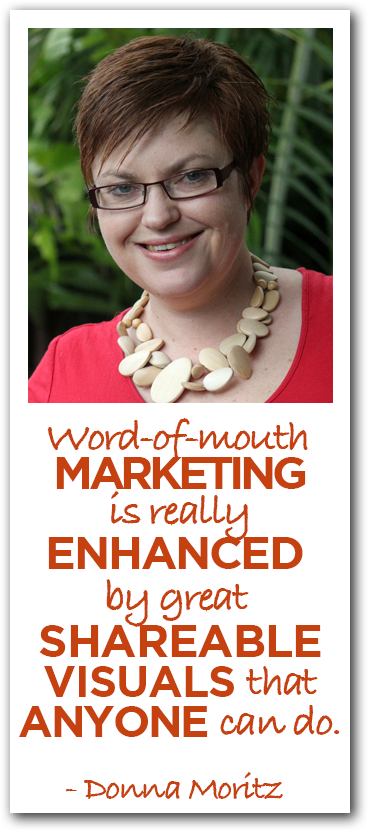 Do you put shareable images on every page of your website? Do you know how to create a compelling infographic or image and what tools you need to make them? Do you know how to tell a story with an image?
Do you put shareable images on every page of your website? Do you know how to create a compelling infographic or image and what tools you need to make them? Do you know how to tell a story with an image?
If not, then you’re not alone. A lot of small businesses don’t realize the importance of “snackable” visual content or how to incorporate it into social media. By connecting with your audience in a visual way, you give them instantly recongnizable content that can propel them to share it with others.
This week, we talk it up with visual social media strategist Donna Moritz, to learn more about how to make interesting infographics and visuals for your most popular platforms and how do it effectively.
Podcast: Play in new window | Download
Subscribe: RSS
Big Ideas:
How did you become a visual social media strategist?
- I was at the Pro Blogger event a couple of years ago, and Darren Rowse was talking about looking for the sparks in your business and how they can lead you in a direction that can really change things completely.
- I realized that when I was blogging I was really interested in topics to do with word-of-mouth marketing and content marketing but I was writing more and more about visual social media that was starting to become a thing. We were using images more on Facebook and Pinterest and Instagram.
- I noticed that my readers were really responding to those articles and I was really enjoying writing them. So I started to do more and then Amy Porterfield asked me to do a blog post which was the first guest post on her site actually.
- Me being excited to do a guest post for Amy I thought, “alright, why don’t we do an infographic,” because infographics were quite big at the time. I’d never done one so I had a designer work with me and we did one on Pinterest and it’s been shared tens of thousands of times, reblogged everywhere.
- I think we’re about to do a 2.0 because it needs updating.
- It showed me the power of good embedded visual content in a great extended blog post. So I became really interested in that.
- I started to do some more. Entrepreneur.com started to post them regularly and they were asking me to do more. From there I started to do some for clients.
- We do them mainly for top bloggers just to get a really good pace of content going. I really love that whole storyboarding and design back and forth and the creation of a visual story.
- I actually a wannabe graphic designer. I never did graphic design but I am really interested in design. I’m quite creative so it’s the perfect fit for me.
So, you’re coming up with the ideas, but you’re having somebody else execute this for you?
- Yeah, and it’s actually good because now a lot of what I do is that I teach people they don’t have to have design skills, they don’t have to have a lot of time, they don’t have to have a design team.
- It’s actually the best time ever to be creating visual content because we have such amazing tools. We never had the tools we have now, two years ago, Canvo, we didn’t have great apps on our phones that allow you to make instant visual content.
- Even though we create high-end infographics, I have a designer who’s also an illustrator because we really want to make them unique. But, I do a lot of my own visual content for my business and also when I have managed clients I have been able to create a lot of visual content using really easy to learn tools.
- We’re now sort of moving into doing visual strategies for businesses and helping them to actually create their own content or doing small projects which might be for a launch or something like that were they need a lot of snackable, easily shared content to promote something.
- Generally, my big passion is helping people to understand that word-of-mouth-marketing is really enhanced by great shareable visuals. Any one can do it.
- When you think about the different types of visuals you can create, they’re not all high-end infographics. Sometimes it’s a very easily produced piece of content that they can do.
- It’s a really good time for people to start playing with it.
What was the information you were trying to get across in this infographic for Amy Porterfield?
- Amy wanted a how-to post about Pinterest because Pinterest had just started to become quite popular. It was also pushing the boundaries of it because when I wrote it it was almost like it could’ve been converted into an ebook.
- It was called the 10 Commandments of Using Pinterest for Business. Pretty much if you go to Amy’s website (amyporterfield.com) it will be one of the most popular posts on the right hand side unless there’s been a change (it’s usually there).
- It was a very simple infographic and it also paved the way for me to think about infographics differently because at the time they were very data driven. They were basically pie charts made to look pretty.
- I thought, “this doesn’t have to be this way. It can tell a story.” So with this one we really just summarized the key points in the article which were the ten commandments. It was nothing special really, it was just some fun birds doing different things to do with the ten commandments and we had dot points under each one.
- It was more of a how-to infographic. Since then we’ve really started to do a lot more that tells a story visually rather than just being data. A lot of them have a lot of how-to tips on them and just trying to make them really useful to people so they’ll want to keep them on their Pinterest boards or on their desktop or however they bookmark information.
- I’ve found that they’re starting to shift from really being just statistics driven to being more useful for people. But, we always include references and things like that at the bottom if we can.
- That first one was just bright, fun, it was engaging, and it was useful so people shared it.
That’s great. So you can be using more than one type of infographic and you can use it to tell a story.
- Yeah, I always include data if I can.
- A good example is one we did for Ian Cleary recently. Ian’s a really smart, savvy blogger and he was amazing to work with because I knew that he would get it promoted quite well (he’s from razorsocial.com and a past guest on this show! view our interview with him HERE http://www.themarketingagents.com/ian-cleary)
- He wanted to do an infographic about different tools, so a “day in the life of a social media marketer.” That one didn’t actually have any statistics on it at all. It was purely different tools and when you would use them.
- The poor girl was working pretty hard during the day. As you moved down the infographic it had lots of different tools you would use on the way to work on the train, mid-morning, lunch, afternoon. I convinced Ian to let the poor lady have a glass of wine in the evening while watching television.
- We had that all designed up and it actually has no stats. It’s just for what tools you wanted to work with it’s great and useful and they’re being used by your industry as a social media marketer you could look at that.
- Now, if you used them all you’d go crazy, but you can pick and choose which ones. It didn’t have any stats at all. I think we referenced a couple of things but it was mainly reference to Ian. It was his content and we just turned it into a story so it wasn’t just a boring list of tools.
Why do you think we’re so drawn to visuals in social media? Why are they so important?
- I was talking about this at Social Media Marketing World. It’s a shift to visual social media.
- We started to communicate more and more in visuals coming from blogs to Facebook with images then to almost completely through marketer blogging and multimedia marketer blogging with Tumblr, and other sites like YouTube and then completely to a point where we’re basically speaking in pictures only on Pinterest and Instagram.
- I used to talk about it being a shift, but it’s actually kind of a return because really we’ve been communicating in new ways, there’s a great quote by Apu Gupta, the CEO of Curalate – “Our ancestors used to communicate what mattered most by drawing on caves and now we pin, we reblog, and we Instagram the things that matter and we’ve kind of come full circle.”
- It’s true. We’re back to communicating with images. I think party it’s because we’re hardwired to communicate visually from the moment we’re born. We react to faces and images.
- Partly, in a way it’s helping us to cut out the noise. There’s so much information coming through that it’s quite obvious when you’re looking at newsfeeds – we do gravitate towards something that catches our attention.
- Text is very hard to catch people’s attention with. An image will catch attention and then it kind of depends on how you structure that image as to what happens afterwards.
- I think there’s a lot of emphasis on reach when that’s great. You can get eyeballs on your content but unless it catches their attention, people aren’t going to do anything with it.
- In general, we’ve come a long way but we’ve kind of almost returned to where we were originally which is back to communicating visually.
- A recent study said that it takes 13 milliseconds to process an image. I love blogging and I love podcasts and video rocks, but we can’t get that same instant emotional connection that images give so it helps people to make a quick decision when they’re seeing content and they’re trying to filter out the stuff that they don’t want from the stuff that they do want.
How do I use an infographic to use it as part of my marketing, my lead generation program?
- The trick is to always think in terms of your homebase and where you want people to be.
- This has kind of changed a little bit and I just want to talk about one thing that you might find interesting, and I’m sure you realize this is happening, historically we’ve always talked about driving traffic to our website which is important, but there’s three types of traffic I think of.
- One is the traffic to your website which is still very much high priority. That’s because you own that space and you own that website. It’s not rented land like on social media sites.
- Then there’s the traffic on your website which is where you want to keep people on your website going from possibly one article to another or however you keep them interested and then hopefully signing up to your newsletter list.
- And then there’s the interesting one which is the traffic away from your website. People might say, “why do you want people to go away from your website?” But to be honest, with sites like Pinterest now there’s a lot of potential for people to share your content back to Pinterest.
- In fact, you can be asleep and have more content shared that has nothing to do with your marketing. You’re not putting content out there. You’re just putting good images or visuals on your website and people will pin it across Pinterest.
- I think the one thing you can do to start with – and anyone can do this – this is just to make sure that every page on your website, infographic or no infographic, has a good piece of visual content on it. Because that way people have an option to actually share that visually. It also makes it more engaging if you’re sharing out to Facebook or Twitter or wherever you want to share it.
- The other thing is when you are choosing to embed something that you are taking the time to do – like an infographic – to make sure that it is in a detailed piece of content that is really helpful to your audience and you know your audience and what they need. Make it really useful.
- For every infographic, and let’s say the one we did for Ian, I said to him part way along as we were designing, “right, mate. It’s your turn. You need to go and write an awesome blog post.” Which for Ian is not really that hard – he’s a very good writer. He went and wrote a great blog post that worked in with the infographic. It wasn’t exactly the same but it referred to the infographic and complemented it.
- Then, when he put that infographic on his site he then shared it out on social media sites but he also offered it up to other bloggers and did blogger outreach for them to share the infographic. All traffic led back to his site.
- So he had two pieces of content. In fact, if that graphic got separated from his website – which it would on Pinterest – it stood alone and it was his own piece of standalone content as well.
- There’s a lot of different things you can do and even just take away smaller pieces of information and turn them into smaller graphics that then lead back into that infographic.
- We call them snackable pieces of content. I hope that makes sense!
If we’re sharing an infographic with people, do we want to share that embed code as well?
- Yeah, I think generally we do that as a rule of thumb now with an embed code.
- There’s a lot of simple plugins that you can use and I can definitely give you some links.
- It is a good idea and it just makes it easier for people because they can just grab the embed code. There’s a lot of people that just share infographics willy nilly and for the most part they’re good or bad at them and they reference them back to the site with a link, but the other way is course is to take the graphic off and upload it to your site.
- Generally that’s considered okay but I think if you’re gonna stick to good copyright and that sort of thing, use an embed code.
- The other thing about embed codes like you said, it makes it easier for the other person as well.
- That’s definitely a good thing to do. I think too, if you’re reaching out to other bloggers just use good common sense. I get spammed a lot with people just sending infographics to me that aren’t really relevant to my readers.
- I know Ian and myself too, we’ve often offered a small guest post to somebody if you’re offering to give them an infographic that you could offer to give them a twist on it and do an introduction on it but sometimes I only need a short paragraph or intro.
- That’s what we do for entrepreneur.com. I’ll publish them on my site and then a day later they’ll post it with an intro paragraph, so there’s a few different ways you can do it.
- Definitely, embed codes are a good way to go.
Many people would say, “we’re a one-man shop, or a small business. We don’t have a lot of money to spend on this. Visuals and infographics are outside of what we can do.” What would you say to that?
- Absolutely not. In fact I have done a couple myself and did some smaller versions as well and I’ll give you a link to an article that’s actually on how to create infographics and it’s got an infographic about how to create infographics embedded in it so it’s kind of a bit “meta.”
- It’s called the “7 Superpowers of a Knockout Infographic.” That’s got a few links to some really great tools you can use that actually are very templates but you can get quite creative with them and add your own branding.
- There’s a tool called Pickto Chart and you can get a free subscription to that and test it out and it’s not a lot per month. There’s one called Easelly and Infogr.am. Those three have their advantages and you can find out which one suits you best but they’re really great tools for creating infographics.
- My other favorite one is Canva because Canva allows you to create graphics of any size so you can do a custom template. You can do a 735px x 4000px high image infographic or you can do shorter, snackable size kind of graphics. On Pinterest, portrait size at least. Something that’s longer than it is wide gets shared better.
- Canva is great because you can just use it to create a simple infographic and they have lots of grids. You can even just put in a simple photo series. I really love the simplicity of a simple photo series showing how to do something in your industry and then like a header and a footer and this is what the infographic is and then the footer with your contact details and just using text overlays.
- Anyone can create a simple graphic or infographic. It’s not that hard. These templates are really really cool. You’d be surprised at how great they can look.
Any specific advice if we have an image should we be repurposing it for different places? Or should we not worry about that?
- Yeah, for sure. I definitely think that repurposing images is a really clever way to go.
- You just have to be a little careful you’re not just putting the one image on every platform. There’s kind of clusters you can look at.
- Firstly if you’re mainly on Instagram and Facebook then obviously square images are the best way to go and you might post it first on Instagram and then repurpose it for Facebook. They post quite well on both.
- With portrait size images, which is sort of a 2:3 aspect ratio like 400 x 600, they do very well on Pinterest. In fact, Curalate did some research and showed that that is the most shared size even more than infographic size, you know, the longer ones. That is a good size to go with.
- I’ve done some testing and it looks okay on Google+ and it looks okay on Facebook so it is good to have some portrait-sized images in your blogpost or just creating them and sharing them right to Pinterest.
- The other size that I’ve been playing around with lately is the size that Facebook recommends for pulling in for your linked images in articles which is like 1200 x 627 and I’ve even reduced that to half to make it fit across the blog post.
- I find you can either use some SEO plugins where Open Graph will pull that image in to make sure it appears nicely on Facebook. Or, I just have that size image on my blog post and that pulls in nicely on Facebook, but it’s also a great size. It’s almost the ideal size for a Twitter image.
- I recommend just occasionally uploading images directly to Twitter. They do get shared better directly into Twitter or second best, through a third-party app. Images on Twitter get twice the number of retweets.
- It pays to think about doing some images, especially for your content that you’re spending a lot of time creating and you can then upload to Twitter as well.
- There are the three sizes – landscape, portrait, and square. Those are the three I tend to go with the most and they would cover most of your platforms in one way or another.
- That’s the tricky part, but it’s not completely cookie cutter. You have to work out what your top platforms are and it comes back to traffic. Where’s the traffic coming from with these images? If it is Facebook and Instagram then focus on that. If it’s Facebook and Pinterest, then do that.
- If you’ve got the time, then do that extra image. Once you’ve got the program open and you’re creating an image, whether it’s getting your designer to do it or you’re doing it, it’s much easier to do them in one go than to try to do it later. Then it doesn’t cost much more in time or money.
- That’s why I say to people, “when you’re creating images, think about a series of images that you could create,” and this is talking about some other tools you can use, like Canva, or another tool like PicMonkey. If you’re creating images you might do a series of two images or quotes or something like that. Don’t just create one, just do five or ten, then you’ve got images for the whole next couple of weeks.
- You kind of inadvertently brought up the topic of batching. People who batch their videos, podcasts, or blog posts, think of images in the same way and do them in a batch so you’re not constantly going, “oh god, we’ve got to do an image for tomorrow.”
What tips and tactics do you have for something like this, whether it’s a brand in general or maybe an event, that we can really get people to share our brand through visual means?
- I mean, if you can get sword swallowers that’s the way to go…or fire breathing, walking on coal, all that stuff is instant shareable images.
- I think there’s a couple elements to it. One is to really give people a slippery slope and make it really easy for them to do it. That part’s kind of covered for us because people are using mobile devices so they often have them in their hand.
- The second is to make them in the moment. So, obviously when you’ve got a sword swallower in front of you that’s a great way to encourage people to share content. But, for a lot of different businesses they think very much about online but just to go offline for a little bit. Sometimes their business might be offline as well.
- For instance, there’s a company called ProDive and they run diving tours. They go out for three days and it’s completely catered for and they dive and they hang out on those beautiful boats. They actually have wi-fi on their boat to encourage people to share images about what they’re experiencing.
- Now, in a conference you obviously have wi-fi and everyone’s there with their phones, cameras, and etcetera. Sometimes it’s as simple as just asking them you know – “I would love you to share images of what’s happening behind the scenes of the conference.”
- It’s always as simple as giving them a hashtag to add to it because it kind of adds the fun. If you need to you can add an enticement of some competition or something like that.
- I had one for my session at Social Media Marketing World where people had 300 pairs of 3-D glasses at the end of the session and had a couple of slides in 3-D just for something fun. But then I got them to do an art imitates like where I’ve been talking to about how to get people to share images, I said, “I want to see the best image using a pair of 3-D glasses by the end of the day,” and people were off taking all sorts of weird and wonderful photos and sharing them with a hashtag.
- In often cases it’s about looking at what sparks your audience. For instance there’s a lady here in Australia who’s a stylist and she often puts up photos of outfits and things like that. She’s a very popular blogger. One of her clients said, “can you post up what you wear every day when you’re going to school pick up and down to the shops or whatever.” So, she posted it up and a simple hashtag #everydaystyle. She didn’t tell them to do anything and people just started to want to post up their own photos of what they were wearing.
- Before long her Facebook community had doubled. She already had a great community. She was posting summaries of hundreds of photos on all of her platforms where people were just sharing these photos with the hashtag #everydaystyle but it was connected to her brand.
- Same thing goes for Tourism Australia. They’re encouraging people to share content about what they experience about our country under hashtags. So hashtags can be very popular and in the moment if you’ve got something happening – an activity or event or an on-location thing – then that can really help.
- If it’s online, then sometimes it’s just about creating great content yourself and encouraging people to add to it. So there’s a number of different ways.
- I’ve seen that done a lot. It always comes back to your audience. It is all about them but they want to participate in what you’re doing. If they’re interested at all in your business they will love to be involved in that behind the scenes activity and being able to contribute in some way.
- So, involving them and asking them what they’re doing while they’re listening to your podcast, Rich, is a brilliant idea. And there’s the beauty because it was your audience’s idea.
- I remember talking to Nicky Parkinson, she’s the stylist at stylingyou.com.au and I said, “how did this start? Did you say to them ‘here’s the hashtag, start sharing photos?’ and she said ‘no, I had someone ask me to do it and I don’t like to tell my audience how to jump through hoops but, then wow, there’s a spark and I’ll follow it.’”
- It’s awesome that your audience thought of that and that they’re running with it. I’ll have to do one from Australia now!
Juicy Links:
- Get in on the early bird discounts for Agents of Change!!
- Donna Moritz’s site was voted the best business blog in Australia!
- Donna Mortiz’s three-part video series on planning, creating and sharing images. (aff)
- Connect with Donna Moritz on Twitter.
- Check out Pickto Chart.
- Check out Easelly.
- Check out Infogr.am.
- Check out Canva.
- Check out Pic Monkey.
- Check out the embed code generator.
- Read Donna’s post: 7 Superpowers of a Knockout Infographic.
- The infographic on Amy Porterfield’s site.
- Infographic done with Ian Cleary
- Article Ian Cleary wrote about how we created and promoted the infogfraphic and the results he got.
- Snackable visual content.
- And be sure to leave a review for The Marketing Agents on iTunes
